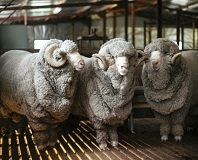Read the latest information on
Foot-and-mouth disease
 Are you experiencing a reduction in lambing percentages or a longer lambing period than normal?
Are you experiencing a reduction in lambing percentages or a longer lambing period than normal?
If the answer is yes, then you should be on the lookout for ovine brucellosis (OB), a bacterial disease in sheep that can enter your flock easily and relatively undetected!
With the ram buying season now in full swing, Animal Health Australia’s Biosecurity Manager, Dr Rob Barwell is reminding producers to be aware of OB, understand what to look out for and know how to avoid the disease.
“OB causes inflammation of the male reproductive organs, in particular the epididymis in rams, resulting in infertility and sterility in some affected rams,” said Dr Barwell.
“OB is inherently a sexually transmitted disease, spread between rams and ewes with the introduction of infected rams being the primary way that OB spreads between properties although strays are also a major risk.
“There are a number of effective strategies you can use to help avoid OB, but there are two key ways to help stop OB coming onto your property. The first, is purchasing rams from OB accredited flocks. There are over 2,000 flocks to choose from around the country, through an OB accreditation scheme. The second most important thing you should do is ensure your fencing is up to scratch so that other sheep cannot stray onto your property and infect your rams,” Dr Barwell said.
If producers think they already have OB on their property, there are ways to check for the disease and ways to manage it, highlighted Dr Barwell.
“The detection of any lesions, irregularities or differences between the contents of the two sides of a ram’s scrotum that cannot be otherwise explained should be checked by a veterinarian. They will likely follow up with confirmatory blood testing for OB.
“All rams should be palpated as a normal part of the preparation of a ram team for mating and those with palpable lesions of the reproductive organs should be culled.
“Infection is spread within the ram mob during joining when clean and infected rams mate with the same ewe and also between rams during the non-joining period,” said Dr Barwell.
To find out how you can purchase animals from an OB accreditation scheme or to find out more information on how to implement biosecurity for your property, visit the Farm Biosecurity sheep industry page.
Take home tips for avoiding OB: